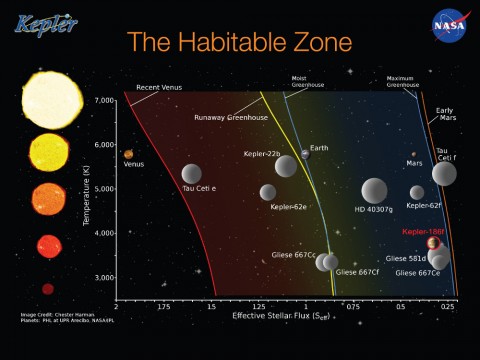The newly discovered planet, Kepler-186f, is the first Earth-size exoplanet circling in its star’s habitable zone. The media worldwide is gleaming with fantastical headlines, but readers in the know may have an inkling the result is less than it seems.
![The diagram compares the planets of our inner solar system to Kepler-186, a five-planet star system about 500 light-years from Earth in the constellation Cygnus. The five planets of Kepler-186 orbit an M dwarf, a star that is is half the size and mass of the sun. [Click link below for more.] Image Credit: NASA Ames/SETI Institute/JPL-Caltech](https://skyandtelescope.org/wp-content/uploads/kepler186f_480-300x168.jpg)
NASA Ames / SETI Institute / JPL-Caltech
NASA’s Kepler mission announced the discovery of Kepler-186f — the smallest and most Earth-like planet found to date — in a press conference today. Only minutes after the embargo lifted, the media worldwide gleamed with fantastical headlines about this potentially habitable planet.
But readers in the know may already have an inkling that these headlines suggest a bigger breakthrough than the research shows.
“Some people call these habitable planets, which of course we have no idea if they are,” says exoplanet expert Stephen Kane (San Francisco State University). “We simply know that they are in the habitable zone, and that is the best place to start looking for habitable planets.”
Here’s the problem: the crippled Kepler space telescope has unleashed a windfall of exoplanets over the years and we’ve been talking about habitable ones ever since. There’s one here, here, and three more here. Oh and we’ve even talked about habitable moons here (but of course we haven’t had much luck on that front yet).
The discovery of habitable exoplanets and even extraterrestrial life is quite possibly the Holy Grail of science. Every astronomer wants to be the one to make the discovery and every reporter wants to be the first to write about it. So we throw around the term Earth-like like it’s a frisbee.
But by definition, to be Earth-like, a planet must be both Earth-size (less than 1.25 times Earth’s girth and less than twice Earth’s mass) and must circle its host star within the habitable zone — the band around a star where water could potentially exist in its liquid state, an essential component for life.
Of the nearly 1,800 confirmed exoplanets found in the past two decades, approximately 10 orbit their host star in the habitable zone. Before today, the smallest exoplanet on this list was Kepler-62f. But at 1.4 times the size of Earth, this exoplanet isn’t Earth-like at all (at least not by our regimented standards). It’s a super-Earth, which could mean it’s a rocky planet with oceans and an atmosphere, or it could be completely gaseous. Without a solar system analogue, the nature of any given super-Earth is hard to pin down.
Kepler-186f sizes in at 1.11 times the girth of Earth. But as with quite a few of Kepler’s planets, the system is too distant and therefore too faint to perform follow-up radial velocity observations, which would show the planet’s gravitational tug on its host star, and therefore reveal its mass. The team has to estimate its weight based on some pretty big assumptions.

NASA
The planet’s small size is a telltale sign that the composition is solid; it will have a hard time holding on to even the lightest elements, such as hydrogen and helium, so it probably doesn’t have a thick gaseous atmosphere either. But its composition could range from pure ice to pure iron, which results in a mass ranging from 0.32 to 3.77 times Earth’s mass. We may find in future years that this planet actually weighs more than twice as much as Earth, making astronomers re-classify it as a super-Earth after all.
Even so, there’s a huge difference between finding an Earth-like exoplanet and finding Earth’s twin. Kepler-186f’s orbit takes it along the outer edge of the star’s habitable zone so any liquid water on the surface would still be in danger of freezing. However, the team hopes that if the exoplanet is a little more massive than the Earth, this extra mass would result in a thicker atmosphere and therefore better insulation.
While Kepler-186f is a first, “it’s not a record we wish to keep,” Quintana says. “We want to find more of these.”
Eventually we’ll have collected a long laundry list of Earth-size exoplanets, and we’ll be able to take a closer look at each one, looking for key elements in their atmospheres and studying the activity of their stars. I fully think that if Earth 2.0 is floating somewhere in the nearby cosmos, we’ll find it. Just not today.
Reference:
Elisa V. Quintana et al. “An Earth-Sized Planet in the Habitable Zone of a Cool Star” Science, April 18, 2014
 0
0









Comments
You must be logged in to post a comment.